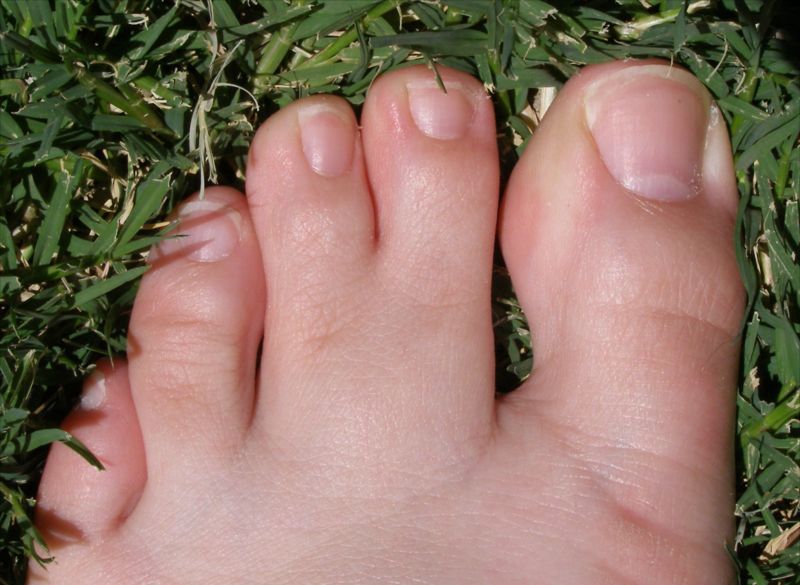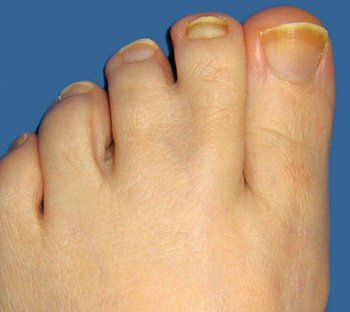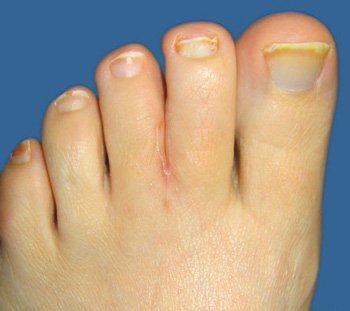Webbed toes
| Webbed toes | |
 | |
|---|---|
| Human foot with partial simple syndactyly. | |
| ICD-10 | Q70.3 |
| ICD-9 | 755.13 |
Template:Search infobox Editor-In-Chief: C. Michael Gibson, M.S., M.D. [1]
Overview
Webbed toes is the common name for syndactyly affecting the feet. It is characterised by the fusion of two or more digits of the feet.
Classification
The scientific name for the condition is syndactyly, although this term covers both webbed fingers and webbed toes. There are various levels of webbing, from partial to complete. Most commonly the second and third toes are webbed or joined by skin and flexible tissue. This can reach either part way up or nearly all the way up the toe.
Pathophysiology
The exact cause of the condition is unknown. In other cases, no other related persons have this condition. Syndactyly occurs when apoptosis or programmed cell death during gestation is absent or incomplete. Webbed toes occur most commonly in the following circumstances:
- Syndactyly or Familial syndactyly
- Down syndrome
It is also associated with a number of rare conditions, notably: [1] [2]
- Acrocallosal syndrome
- Apert's syndrome
- Aarskog syndrome
- Bardet-Biedl syndrome
- Carpenter's syndrome
- Cornelia de Lange syndrome
- Edwards syndrome
- Jackson-Weiss syndrome
- Fetal hydantoin effect
- Miller syndrome
- Pfeiffer syndrome
- Smith-Lemli-Opitz syndrome
- Timothy syndrome
Pathophysiology
Women have yet another reason to stop smoking while pregnant. In the largest study of its kind, plastic surgeons found smoking during pregnancy significantly elevates the risk of having a child with excess, webbed or missing fingers and toes, according to the January issue of Plastic and Reconstructive Surgery, the official medical journal of the American Society of Plastic Surgeons (ASPS). In fact, the study found that smoking just half a pack per day increases the risk of having a child born with a toe or finger defect by 29 percent.
"Reconstructive surgery to repair limb, toe and finger abnormalities in children represents a large portion of my practice - it is the most common issue I treat," said Benjamin Chang, MD, ASPS member and study author. "Parents would ask why this happened to their child, but I didn't have an answer. This study shows that even minimal smoking during pregnancy can significantly increase the risk of having a child with various toe and finger defects."
Researchers examined the records of more than 6.8 million live births in the United States during 2001 and 2002, finding 5,171 children born with a digital anomaly where the mother smoked during pregnancy but did not suffer from other medical complications, such as heart disease, diabetes or high blood pressure.
The study authors discovered pregnant women who smoked one to 10 cigarettes per day increased the risk of having a child with a toe or finger deformity by 29 percent. The more a woman smoked, the higher the risk became. Women who smoked 11 to 20 cigarettes a day raised the risk 38 percent, and women who smoked 21 or more cigarettes per day raised the risk 78 percent.
Known as polydactyly, syndactyly and adactyly, these deformities are the most common congenital limb abnormalities. Polydactyly is the presence of more than five digits on the hands or feet. Syndactyly is having fused or webbed fingers or toes. Adactyly is the absence of fingers or toes.
Webbed fingers or toes occur one in every 2,000 to 2,500 live births and excess fingers or toes occur one in every 600 live births.
Webbed fingers or toes occur twice as often in boys and are more common in Caucasians than African Americans. Excess digits, however, are 10 times more common in African Americans and are only slightly prevalent in boys. Nevertheless, the majority of these defects occur without any family history and most causes are unknown which has lead researchers to investigate environmental causes, such as smoking, for these anomalies.
"The results of this study were interesting. We suspected that smoking was a cause of digital anomalies but didn't expect the results to be so dramatic," said Dr. Chang. "Smoking is so addictive that pregnant women often can't stop the habit, no matter what the consequences. Our hope is this study will show expectant mothers another danger of lighting up.
Epidemiology and Demographics
In humans it is considered unusual, occurring in approximately one in 2,000 to 2,500 live births.
Diagnosis
This condition is normally discovered at birth. If other symptoms are present, a specific syndrome may be indicated. Diagnosis of a specific syndrome is based on a family history, medical history, and a physical exam.
Family History
In some cases, close family members may share this condition.
Consequences
Webbed toes is a purely cosmetic condition. This condition does not impair the ability to perform any activity including walking, running, or swimming. There is no evidence that it improves swimming ability. Webbed toes can interfere with the ability to wear toe rings and toe socks.
People with webbed toes may have a slight disadvantage for activities that benefit from prehensile toes.
Webbed toes eliminate the possibility of athlete's foot infections in the affected areas.
Psychological stress may arise from the fear of negative reactions to this condition from people who do not have webbed toes. This may lead some individuals to become extremely self-conscious about their feet and go to great lengths to hide them. They may avoid open-toed footwear and activities such as swimming where their feet may be seen. In reality, other people rarely notice this condition unless the person with this condition makes a deliberate effort to point it out.
Surgery
Webbed toes can be separated through surgery. Surgical separation of webbed toes is an example of body modification.
As with any form of surgery, there are risks of complications.
The end results depend on the extent of the webbing and underlying bone structure. There is usually some degree of scarring, and skin grafts may be required. In rare instances, nerve damage may lead to loss of feeling in the toes. There are also reports of partial web grow-back. The skin grafts needed to fill in the space between the toes can lead to additional scars in the places where the skin is removed.
Famous People with Webbed Feet
- Dan Aykroyd – Canada, actor
- Kentaro Miura - Japan, mangaka
- Marge Simpson - United States, cartoon character (mentioned in her trial for shoplifting)
- Joseph Stalin (Unproven) – Soviet Union, General Secretary of the Communist Party of the Soviet Union
- Paul Meyer - Austria, hero
- Ashton Kutcher [3] - American, actor
References
- ↑ Sailer, Christian, Wasner, Susanne. Differential Diagnosis Pocket. Hermosa Beach, CA: Borm Bruckmeir Publishing LLC, 2002:77 ISBN 1591032016
- ↑ Kahan, Scott, Smith, Ellen G. In A Page: Signs and Symptoms. Malden, Massachusetts: Blackwell Publishing, 2004:68 ISBN 140510368X
- ↑ "IMDB". Retrieved 2007-04-11.
Additional Resources
- Journal of the American Society of Plastic Surgeons. Li-Xing Man, M.Sc.; Benjamin Chang, M.D. "Maternal Cigarette Smoking during Pregnancy Increases the Risk of Having a Child with a Congenital Digital Anomaly." January 2006, pg. 301.

